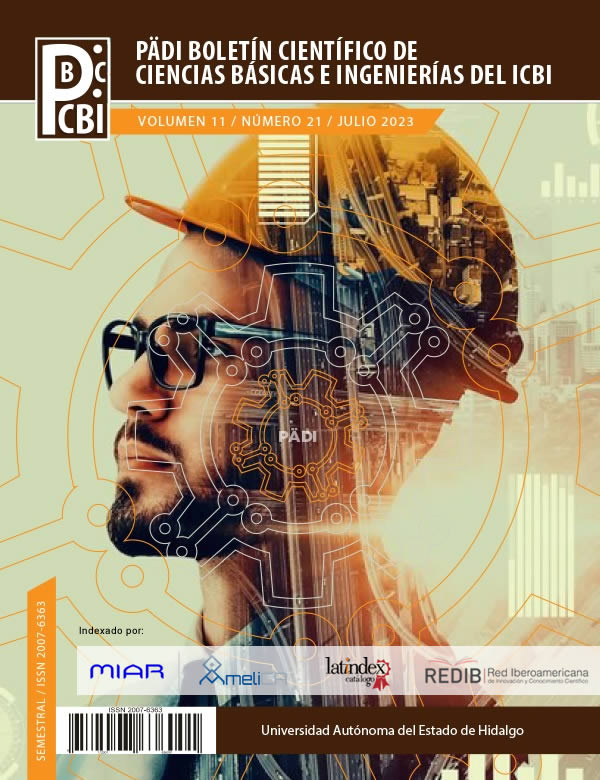A mechanistic study for obtaining methanol from CO
Abstract
A mechanistic study of the catalytic hydrogenation of carbon monoxide for generating methanol with the tetranuclear cluster of ruthenium (Ru4) was carried out, applying the density functional theory (DFT) with the exchange and correlation functional PBE and the orbital base 6-31G** for the C, O, H atoms and for the ruthenium cluster an effective core potential LANL2DZ was used. Energy barriers lower than 30 kcal/mol and DG = -13.3 kcal/mol show a favorable reaction mechanism for the generation of methanol.
Downloads
References
Abdelkareem, M. A., Lootah, M. A., Sayed, E. T., Wilberforce, T., Alawadhi, H., Yousef, B. A., & Olabi, A. G. (2021). Fuel cells for carbon capture applications. Science of The Total Environment, 769, 144243. DOI: 10.1016/j.scitotenv.2020.144243
Adams, B. D., Asmussen, R. M., Chen, A., & Mawhinney, R. C. (2011). Interaction of carbon monoxide with small metal clusters: a DFT, electrochemical, and FTIR study. Canadian Journal of Chemistry, 89(12), 1445-1456. DOI: 10.1139/v11-120
Al‐Mamoori, A., Krishnamurthy, A., Rownaghi, A. A., & Rezaei, F. (2017). Carbon capture and utilization update. Energy Technology, 5(6), 834-849. DOI:10.1002/ente.201600747
Bae, Y. C., Osanai, H., Kumar, V., & Kawazoe, Y. (2005). Atomic structures and magnetic behavior of small ruthenium clusters. Materials transactions, 46(2), 159-162. DOI: 10.2320/matertrans.46.159
Ernzerhof, M., & Scuseria, G. E. (1999). Assessment of the Perdew–Burke–Ernzerhof exchange-correlation functional. The Journal of chemical physics, 110(11), 5029-5036. DOI: 10.1063/1.478401
Frisch, M. J., Trucks, G. W., Schlegel, H. B., Scuseria, G. E., Robb, M. A., Cheeseman, J. R., & Fox, D. J. (2016). Gaussian 09, Revision A. 02, Gaussian, Inc., Wallingford CT
Ge, G. X., Yan, H. X., Jing, Q., & Luo, Y. H. (2011). Theoretical study of hydrogen adsorption on ruthenium clusters. Journal of Cluster Science, 22(3), 473-489. DOI: 10.1007/s10876-011-0395-1
Hariharan, P. C., & Pople, J. A. (1973). The influence of polarization functions on molecular orbital hydrogenation energies. Theoretica chimica acta, 28(3), 213-222. DOI: 10.1007/bf00533485
Hay, P. J., & Wadt, W. R. (1985). Ab initio effective core potentials for molecular calculations. Potentials for the transition metal atoms Sc to Hg. The Journal of chemical physics, 82(1), 270-283. DOI: 10.1063/1.448799.
Jensen, F. (2007) Introduction to Computational Chemistry Second Edition Ed. John Wiley & Sons. Cap.12. Pags. 416-417.
Loveless, B. T., Buda, C., Neurock, M., & Iglesia, E. (2013). CO chemisorption and dissociation at high coverages during CO hydrogenation on Ru catalysts. Journal of the American Chemical Society, 135(16), 6107-6121. DOI: 10.1021/ja311848e
Ou, Z., Qin, C., Niu, J., Zhang, L., & Ran, J. (2019). A comprehensive DFT study of CO2 catalytic conversion by H2 over Pt-doped Ni catalysts. International Journal of Hydrogen Energy, 44(2), 819-834. DOI: 10.1016/j.ijhydene.2018.11.008
Rangel P. U. J., Zárate H. L. A., Camacho, M. R. L., González, M ., & Cruz, B. J. (2021). Estudio TFD de cúmulos de Pt-Ir con geometría prisma triangular. Pädi Boletín Científico de Ciencias Básicas e Ingenierías del ICBI. DOI: 10.29057/icbi.v9iEspecial2.7996
Srivastava, S., & Pahuja, A. (2014). Magnetic properties of small ruthenium clusters in fullerene cage—A DFT study. International Journal of Modern Physics B, 28(27), 1450184. DOI: 10.1142/s0217979214501847
Sun, K., Rui, N., Zhang, Z., Sun, Z., Ge, Q., & Liu, C. J. (2020). A highly active Pt/In 2 O 3 catalyst for CO 2 hydrogenation to methanol with enhanced stability. Green Chemistry, 22(15), 5059-5066, DOI: 10.1039/d0gc01597k
Wilberforce, T., Olabi, A. G., Sayed, E. T., Elsaid, K., & Abdelkareem, M. A. (2021). Progress in carbon capture technologies. Science of The Total Environment, 761, 143203. DOI: 10.1016/j.scitotenv.2020.143203
Zhang, W., Xiao, L., Hirata, Y., Pawluk, T., & Wang, L. (2004). The simple cubic structure of Ir clusters and the element effect on cluster structures. Chemical physics letters, 383(1-2), 67-71. DOI: 10.1016/j.cplett.2003.11.005
Zeinalipour-Yazdi, C. D., Cooksy, A. L., & Efstathiou, A. M. (2008). CO adsorption on transition metal clusters: trends from density functional theory. Surface science, 602(10), 1858-1862. DOI: 10.1016/j.susc.2008.03.024
Zheng, H., Narkhede, N., Han, L., Zhang, H., & Li, Z. (2020). Methanol synthesis from CO2: a DFT investigation on Zn-promoted Cu catalyst. Research on Chemical Intermediates, 46(3), 1749-1769. DOI:10.1007/s11164-019-04061-2
Copyright (c) 2023 Angelly Reyes-Zambrano, Luis Ángel Zárate-Hernández, Julián Cruz-Borbolla, José Manuel Vásquez-Pérez, Israel Samuel Ibarra-Ortega, Rosa Luz Camacho-Mendoza

This work is licensed under a Creative Commons Attribution-NonCommercial-NoDerivatives 4.0 International License.













